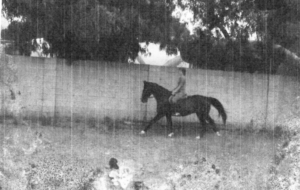By Susan Schmieg
My trek to becoming a physical therapist at Sprout started when I first fell in love with riding horses. I feel riding and watching horses move taught me to be able to pinpoint the problem areas in my patients and after learning how to treat patients I can see and feel how the movements of horses impact the mind and body of humans. It is the correct movement of horse that is the real therapy and the therapist can challenge the patient by redirecting the forces of the movement.
I do not remember a time when I was not infatuated with horses. The first pony I rode was a handsome pinto named Ajax. I was three years old when I was introduced to riding through my uncle’s friends Dell and Dieter from Germany. I rode many horses and ponies with Dell and I never remember her telling me that I rode well but she would say to me that I was very brave and strong. Dell believed that balance was the key to good riding and started the youngest riders in a Western saddle. She would then progress riders to a “balanced seat” over fences; which was not like our hunt seat position that I learned with a later instructor, and a “deep seat” for dressage. Dieter and Dell returned to Germany when I was 8 years old. That was a very sad time for me because the farm was sold and all the horses and ponies were sold to different families.
Shortly thereafter, my parents found out that a classmate of mine was taking lessons at a program called Junior Equitation School at Full Cry Farm in Vienna. It was beautiful, big fields with hills and arenas and many barns. I had multiple instructors and rode wonderful horses during my many happy years at Full Cry. I learned to stay in “jump position” or “2 point” over a full course of fences including up AND downhill; I worked in the barns and learned to assist with beginner lessons. I even lea rned to drive a tractor before I could drive a car. Through people who would “ride in” or trailer to their lessons I began to ride outside of Full Cry. I learned to ride open jumpers and to go cross country. Eventually, I started to event horses with a family who had a small riding school in Herndon. To pay for my training I taught beginner lessons and when I was 16 my trainer gave me a most special “summer assignment”. I was to work with a little boy who had disabilities causing him to need a wheelchair. I had never met a child who needed a wheelchair and was surprised to hear that his family and his doctor wanted him to learn to ride.
rned to drive a tractor before I could drive a car. Through people who would “ride in” or trailer to their lessons I began to ride outside of Full Cry. I learned to ride open jumpers and to go cross country. Eventually, I started to event horses with a family who had a small riding school in Herndon. To pay for my training I taught beginner lessons and when I was 16 my trainer gave me a most special “summer assignment”. I was to work with a little boy who had disabilities causing him to need a wheelchair. I had never met a child who needed a wheelchair and was surprised to hear that his family and his doctor wanted him to learn to ride.
His doctor was trained in Europe where they used horses and ponies as therapy for a variety of health problems and since my rider’s sister rode at my barn the family thought this was where he also needed to be. I don’t remember if I was ever given his diagnosis; but the first time I met him; he was not even able to sit erect in his wheelchair. The plan was for him to have physical therapy 3 times a week and me 2 times a week the first week and then have me 3 times a week and therapy twice the next week, alternating through the summer. I was told that his physical therapy goals were to sit independently on a bench for greater than 1 minute and to stand using a walker.
 I knew nothing about therapy and treating disabilities; however, I did know how some one should hold their posture on a horse. So, I squeezed and tickled and poked this little boy until he could sit while the pony walked patiently around the arena performing the magic of equine movement. I taught my rider to halt without losing his balance and soon he learned to squeeze with his legs to make the pony walk forward. During this time in therapy not only did he learn to sit independently on a bench and a rocker board, but he also began to take steps with a rolling walker. He was getting stronger almost every week he rode and at the end of summer we had a small horse show for all the students and he was in the walk lead line class with 9 able bodied riders and got a third place ribbon. His doctor was an advocate for using horses in therapy and had a brochure sent to me about therapeutic riding and on the last page in small print it said each program needs a physiotherapist on staff to perform evaluations of each rider. I wanted to be a professional rider/trainer but my parents were demanding that I go to college. I told them that I now wanted to be a physical therapist and use horses to treat my patients.
I knew nothing about therapy and treating disabilities; however, I did know how some one should hold their posture on a horse. So, I squeezed and tickled and poked this little boy until he could sit while the pony walked patiently around the arena performing the magic of equine movement. I taught my rider to halt without losing his balance and soon he learned to squeeze with his legs to make the pony walk forward. During this time in therapy not only did he learn to sit independently on a bench and a rocker board, but he also began to take steps with a rolling walker. He was getting stronger almost every week he rode and at the end of summer we had a small horse show for all the students and he was in the walk lead line class with 9 able bodied riders and got a third place ribbon. His doctor was an advocate for using horses in therapy and had a brochure sent to me about therapeutic riding and on the last page in small print it said each program needs a physiotherapist on staff to perform evaluations of each rider. I wanted to be a professional rider/trainer but my parents were demanding that I go to college. I told them that I now wanted to be a physical therapist and use horses to treat my patients.

My parents insisted that I volunteer at a hospital to learn what physical therapists really do and I became a Red Cross volunteer. I was assigned to the rehabilitation department at a small local hospital during the summer after my Junior year in high school. The director who was my immediate supervisor was awesome. Her name was Betty Phillips and she had served in the Marines. Over the course of the summer she taught me how to take blood pressures and use a stethoscope to take someone’s pulse listening to heart sounds, how to set a patient up for traction and how to direct a patient through a series of exercises. She let me do things that I now know as a PT that we don’t allow students/volunteers perform. I learned many techniques from Betty but the most important thing I learned was to be “patient with my patients” because they were trying as hard as they possibly could at that given moment and there are many factors that impact a person’s healing. I left that hospital rotation and Betty left shortly after to start the Physical Therapy Assistant program at Northern Virginia Community College.
After high school I went to Mary Washington College (now University) in Fredericksburg, Virginia where I continued to ride and work in the riding program. During my first summer home I learned about a therapeutic riding program in Great Falls and began to volunteer there. The director had completed her therapeutic riding instructor training in England after her initial college degree. She eventually wanted to be an occupational therapist and thought my plan to be a physical therapist would mesh well for the program. I volunteered frequently through college and eventually we both were accepted into schools to complete our professional degrees. Once out of school we reconnected starting Lift Me UP and working at Mt. Vernon Hospital. The next year we both got married. She and her husband moved to Germany and my husband and I moved to California. I worked with several therapeutic riding programs in California but always felt that the therapeutic benefits were secondary to teaching riding skills. There was a small group of therapists that had a program in San Jose who used horses to increase the impact of their clinical practices and actually had a treatment room at the barn where they could treat on the horse or off. I continued to see patients in a variety of settings including on horses and after our two children were born my husband accepted a job back here in northern Virginia.
Once back in Virginia I resumed working with Lift Me Up but returned to full time clinical work when we needed to plan to send our children to college. I continued to ride with friends because no one can ever give up being with horses once smitten. As I continued on my journey as a therapist, I was given the opportunity to be more than a clinical instructor and initiated an education protocol for all staff including nursing staff at the hospital I worked in. I realized quickly that there were many areas that I needed to have first hand knowledge about for the new grads. I decided to return to Virginia Commonwealth University to get my Doctor of Physical Therapy degree. I really felt old and out of step when I was told that they had changed the name of the muscles on the outside of the lower leg. I received my degree in 2011 right after I accepted a position at Inova Loudoun Hospital. Shortly after that my boss came to me and asked if it was true that I knew a little about riding therapy. She and the director had met someone who had a small program in Aldie and they wanted my opinion about the benefits and possibility of a hospital outpatient clinic working with such a program. I was so excited and that program was Sprout. We made a visit and I outlined a plan for the clinic; however, the legal department felt it was not a billable treatment and it would increase liability that they did not want to take on. The clinic decided not to go forward but I had already committed to Sprout in my head and decided to join the staff at Sprout. I retired from Inova in 2016 but continue with Sprout and a few other special projects.

















